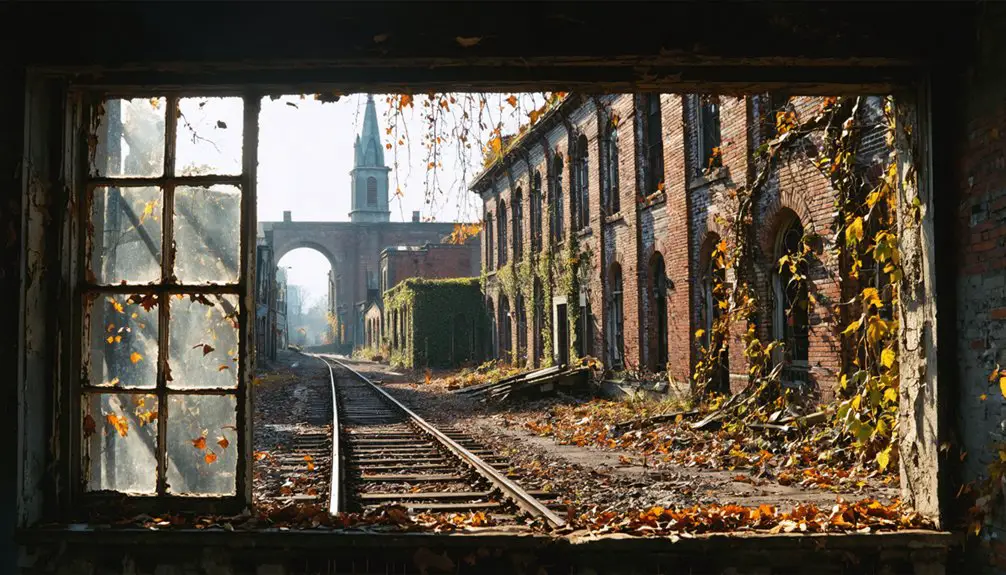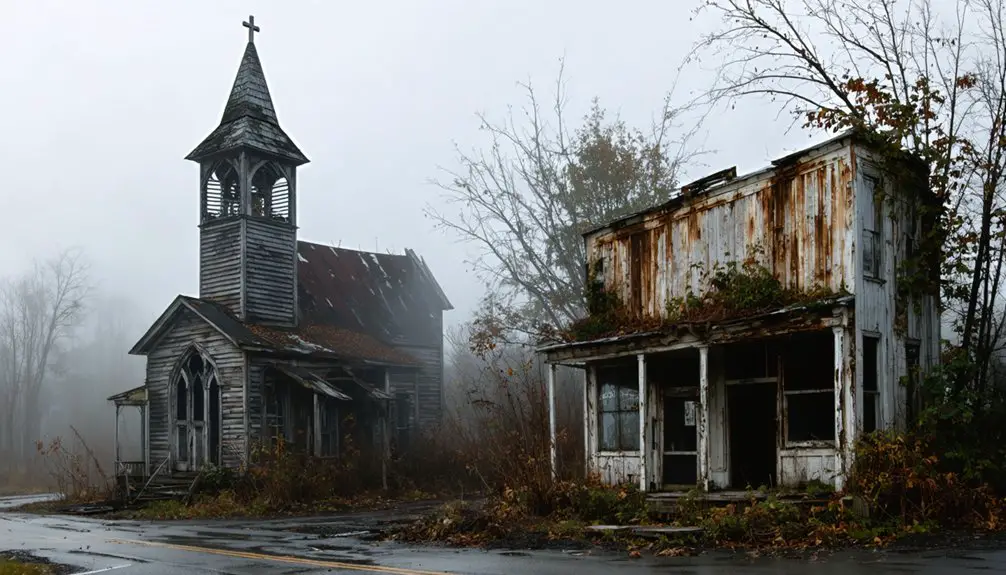You’ll discover Hart Town’s fascinating transformation from Joseph Hart’s farm into a booming coal mining community that peaked at 1,500 residents in the 1960s. The town thrived with immigrant laborers, company houses, and daily coal production reaching 6,000 tons. Today, you can explore the haunting remnants of this Pennsylvania ghost town, where abandoned mine shafts, toxic soil, and decaying infrastructure tell a deeper story of America’s industrial past.
Key Takeaways
- Hart Town began as a coal mining community built on Joseph Hart’s former property, employing over 1,600 miners by 1910.
- The town reached its peak population of 1,500 residents in the early 1960s with thriving coal operations producing 6,000 tons daily.
- Environmental damage includes abandoned mine shafts, acid mine drainage, contaminated waterways, and persistent coal dust issues.
- Physical remains include scattered mining equipment, building foundations, and deteriorating infrastructure affected by underground mine fires.
- The site now attracts dark tourism visitors, generating $1.7 million annually despite ongoing environmental hazards and preservation challenges.
The Rise and Fall of a Mining Community
While many Pennsylvania mining towns emerged during the early 1900s coal boom, Hart Town’s story began uniquely on Joseph Hart’s former farm and woolen mill property. The mine utilized the efficient room-and-pillar method to extract coal from underground seams. You’ll find community resilience displayed in how quickly the town adapted, with Hyde-Murphy building worker housing in 1903 as coal operations expanded. The mine’s rapid growth was evident as employment increased dramatically from 513 miners in 1904 to over 1,600 workers by 1910.
Life in Hart Town’s Golden Era
During Hart Town’s peak in the early 1960s, you’d find a bustling community of 1,500 residents, where coal miners’ families lived in tightly packed homes and frequented the local shops and gas stations along Route 61.
You could hear the rhythmic sounds of mining operations throughout the day while children played in nearby yards and wives tended to household duties, creating the familiar tempo of a Pennsylvania coal town.
The social fabric was woven through shared church services, community gatherings, and the common understanding that everyone’s livelihood depended on the coal seams running beneath their feet. Much like nearby Centralia’s 2,700 residents, the town thrived on the prosperity that coal mining brought to the region. The town’s fate would later mirror Centralia’s when underground mine fires forced many families to relocate.
Prosperous Coal Mining Days
As World War I fueled unprecedented demand for coal in the 1910s, Hart Town emerged as a thriving mining community within Pennsylvania’s lucrative Whiskey Run complex.
At its peak, you’d find over 60 company houses, a bustling company store, and a doctor’s office serving the town’s hardy mining families.
During this coal boom, the Iselin mines churned out an impressive 6,000 tons daily, but this prosperity came at a steep human cost. Many of the workers were immigrant laborers who had arrived from central and southern Europe seeking better opportunities.
You’d see miners crawling through cramped three-foot-high tunnels, battling suffocating heat and coal dust while earning just 38 cents per ton. The miners’ day would start when the whistle blew at dawn, signaling the beginning of another grueling shift underground.
Despite the labor struggles and dangerous conditions, including the constant threat of rock falls and gas explosions, these determined workers persevered, producing about 10 tons each day using nothing more than picks and shovels.
Community and Social Life
Beyond the coal dust and daily toil, Hart Town’s social fabric thrived through a vibrant mix of churches, community halls, and ethnic organizations that defined small mining town life in the early 1900s.
Similar to Centralia’s thriving nightlife, the town featured over two dozen saloons where miners would gather after work.
You’d find yourself immersed in a close-knit world where community gatherings shaped daily life – from baseball games and seasonal festivals to church socials and union meetings.
The town’s social traditions reflected its diverse immigrant population, with Eastern and Southern European customs enriching local culture.
After long shifts in the mines, you’d join your neighbors at social halls for dances, picnics, and traveling shows.
Despite harsh working conditions and economic uncertainties, strong family bonds and mutual aid societies helped residents weather life’s challenges, creating an enduring spirit of resilience that defined Hart Town’s golden era.
Like many towns of the era, Hart Town’s population eventually declined to just one fifth of its peak as the coal industry began to fade.
Environmental Legacy and Mining Impact
The environmental scars from Hart Town’s coal mining operations continue to plague the landscape today, serving as stark reminders of Pennsylvania’s industrial past.
You’ll find abandoned mine shafts, towering spoil heaps, and contaminated waterways where Harpers Run once flowed freely. The legacy of acid mine drainage has left streams tainted with heavy metals, while collapsed underground voids threaten surface stability.
Environmental restoration efforts face the challenge of addressing widespread soil contamination and persistent coal dust that once filled miners’ lungs. The impact mirrors the broader challenges faced by anthracite mining towns across Pennsylvania’s coal regions. The town’s contamination mitigation needs are substantial – from treating acidic water seeping from old mine workings to stabilizing land compromised by subsidence.
These environmental challenges, combined with altered groundwater patterns, have left an indelible mark on Hart Town’s former coal country.
Structural Remains and Archaeological Evidence
As you walk through Hart Town’s abandoned landscape, you’ll find scattered mining equipment and rusted machinery that tell the story of its industrial past.
Similar to other ghost town disambiguation cases, the building foundations reveal a once-thriving community’s layout, with clear patterns showing where homes and businesses once stood along the town’s grid system.
The decaying infrastructure, from broken water mains to crumbling power poles, provides a stark reminder of how quickly a town can fade when its economic backbone collapses.
Mining Equipment Remnants
Scattered across Hart Town’s abandoned mining landscape, rusted equipment and crumbling infrastructure tell the story of Pennsylvania’s coal mining heritage.
You’ll find mining cart remnants partially buried near old loading zones, their metal frames slowly surrendering to time and elements. These historical artifacts paint a vivid picture of the town’s bustling past.
- Rusted rail tracks snake through overgrown vegetation, marking paths where coal-laden carts once rolled.
- Discarded tools – pickaxes, shovels, and mine picks – lie scattered near shaft entrances.
- Weathered winches and cable drums stand as silent sentinels by collapsed mine openings.
- Fragments of steel conveyor belts stretch across the terrain, remnants of the coal’s final journey.
These industrial relics serve as powerful reminders of Hart Town’s role in America’s coal mining era.
Building Foundation Patterns
Standing proof to Hart Town’s coal mining legacy, foundation patterns reveal intricate details about the community’s architectural history and social structure.
You’ll find various foundation styles throughout the site, from irregular fieldstone walls to fired clay brick remnants, telling the story of both modest homes and larger boarding houses. The foundations showcase a well-planned community with grid-like street patterns and carefully constructed cellars.
The town’s battle with mining subsidence effects is evident in the cracked and displaced foundations. You can spot where residents attempted to reinforce their homes with concrete and additional stone packing to fight against the shifting ground.
Near mine shafts, you’ll discover truncated foundations and filled-in sinkholes – silent testimonies to the ultimate fate that forced many to abandon their homes.
Decaying Infrastructure Elements
Beyond the building foundations, Hart Town’s decaying infrastructure tells a haunting story of urban abandonment.
You’ll find historical remnants scattered throughout this Pennsylvania ghost town, where nature steadily reclaims what humans left behind. The town’s urban decay is most evident in its deteriorating roadways, especially the infamous “Graffiti Highway” that’s now buried beneath dirt.
- Concrete fire hydrants and retaining walls stand as silent sentinels, marking where neighborhoods once thrived.
- Buckled sidewalks and cracked road surfaces reveal the destructive force of underground mine fires.
- Disconnected manhole covers and utility access points hint at the town’s former municipal services.
- Venting tubes pierce the ground like industrial sculptures, still releasing pressure from the endless inferno below.
Ghost Town Tourism and Cultural Significance
While many abandoned towns fade into obscurity, Hart Town‘s remnants have become part of Pennsylvania’s thriving ghost town tourism scene, drawing visitors from across the southwestern region and beyond.
You’ll find yourself among diverse travelers, as tourism trends show visitors coming from nearby Cambria and Indiana counties, with over 7% traveling from outside the region entirely.
Like other ghost towns along Pennsylvania’s historic trails, Hart Town’s cultural heritage speaks through preserved industrial sites and interpretive displays that tell the story of the state’s coal-mining past.
When you explore these grounds, you’re participating in a larger movement of “dark tourism” that generates roughly $1.7 million annually through visitor spending, while helping preserve these essential connections to Pennsylvania’s industrial legacy.
Preservation Challenges and Future Outlook

Despite ongoing preservation efforts, Hart Town faces severe challenges that mirror the struggles of Pennsylvania’s most notorious ghost town, Centralia.
Traditional preservation techniques prove nearly impossible due to the unstable ground conditions and toxic environment that threaten both structures and visitors.
The town’s toxic soil and unstable terrain render standard preservation methods futile, putting both historic buildings and people at constant risk.
- You’ll find that conventional restoration methods can’t address the continuous degradation from underground fires that could burn for another 200+ years.
- Safety concerns have forced officials to restrict access, limiting your ability to explore or document historical sites.
- Environmental hazards, including toxic gases and potential sinkholes, make it dangerous to implement any long-term preservation plans.
- Future prospects remain grim as the persistent underground fire continues to destroy both surface infrastructure and the town’s historical legacy.
Frequently Asked Questions
Are There Any Documented Paranormal Activities or Ghost Sightings in Hart Town?
You won’t find any officially documented ghostly encounters or spectral sightings in this area. Unlike Centralia’s well-known paranormal reputation, there’s no credible evidence of supernatural activity here.
What Happened to the Families Who Were Forced to Leave Hart Town?
Home is where the heart is, but you’ll find these families scattered across Pennsylvania towns after their forced relocation. They’ve faced economic hardship and broken community bonds, carrying their historical legacy wherever they settled.
Was Hart Town Connected to Any Significant Criminal Activities During Mining Days?
You won’t find documented criminal enterprises linked specifically to Hart Town, though like other mining communities, it likely experienced typical issues of labor disputes, theft, and questionable company practices following mining accidents.
Did Hart Town Have Its Own School System or Church Buildings?
Like a defunct social media network, Hart Town’s school history and church architecture aren’t well documented. You won’t find records of dedicated schools or churches surviving from its mining heyday.
What Was the Peak Population of Hart Town During Its Most Prosperous Period?
You’ll find historical records don’t show exact figures, but during its peak prosperity around 1900, the population likely reached several hundred residents before experiencing population decline with the lumber industry’s collapse.
References
- https://www.youtube.com/watch?v=8QDb8y9Nszs
- https://www.youtube.com/watch?v=aCMVl6iCA78
- https://en.wikipedia.org/wiki/List_of_ghost_towns_in_Pennsylvania
- https://www.worldatlas.com/cities/you-won-t-believe-this-town-is-in-pennsylvania.html
- https://en.wikipedia.org/wiki/Centralia
- https://www.iup.edu/library/departments/archives/coal/mines-and-company-towns/the-company-town-of-iselin.html
- https://en.wikipedia.org/wiki/Coal_mining_in_Plymouth
- http://iiif.library.cmu.edu/file/Heinz_box00022_fld00006_bdl0005_doc0006/Heinz_box00022_fld00006_bdl0005_doc0006.pdf
- https://www.pa.gov/agencies/dep/programs-and-services/mining/bureau-of-mining-programs/pa-mining-history.html
- https://raystown.org/blog/post/coal-mining-a-hard-knock-life/



